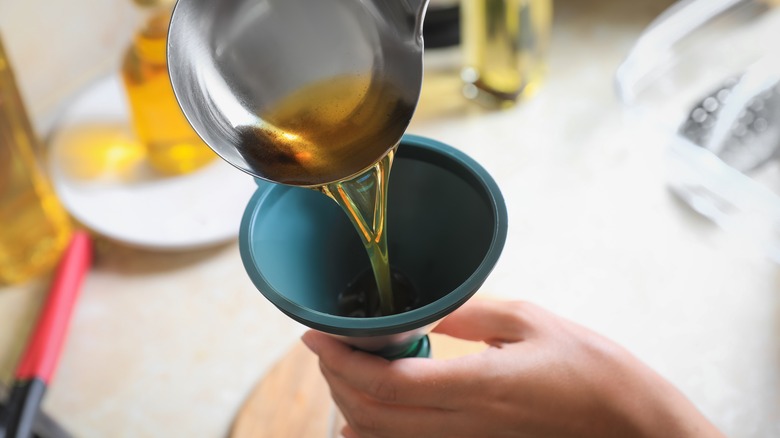The Secret To Effortlessly Cleaning Up Frying Oil Is Already In Your Pantry
Whether you've conquered legitimately crispy French fries at home or the perfect fried chicken, you're probably left with a full belly ... and a full pot of dirty frying oil that you don't know what to do with. There are myriad reasons why throwing out that frying oil is a huge mistake, as dumping it down the drain can be a plumbing nightmare, and not to mention, wasteful. There are actually plenty of ways to use leftover cooking oil, and one is to simply re-use it the next time you want to fry something up. However, it's important that the oil is cleaned before you can do that. Say hello to cornstarch.
This simple ingredient works wonders to remove all the burnt bits and impurities from used oil, leaving it clean for reuse. To begin, start by letting your frying oil cool. Then, mix a quarter cup of cornstarch with a cup of water to create a slurry, before adding it into your cold oil. Slowly heat the mixture on the stove while stirring it. When the cornstarch starts to clump together, you're on the right track. Once the cornstarch blob starts to float on the surface, pour the oil through a strainer, catching that glob of cornstarch which has absorbed all those icky impurities. Now, you're left with clean, usable frying oil. This trick not only saves money but also ensures that your food tastes great without any burnt residue.
Know when to let your frying oil go
Cleaning your frying oil with cornstarch extends its usability, but it won't last forever. Stored properly in a closed container in a cool, dark area, you can get at least a few round of frying out of one batch of oil. Generally, it's agreed upon that you can reuse your frying oil around three or four times before it's time to give it up. However, if your oil starts to smell rancid or has an off-putting odor, that's a strong indicator it has gone bad. A change in color, especially if it turns dark or cloudy, means it has accumulated too many impurities and it's time to throw it away. Additionally, if the used oil has been stored for longer than a month or two, regardless of its smell or look, it's best to toss it.
When the oil is bad, your fried food might start coming out greasy instead of crispy, and the taste may not be the best. At this point, it's time to say goodbye — but there are plenty of reasonable ways to dispose of your cooking oil safely. Before you trash it, be sure to let it cool and transfer it to a sealed container. Or, you could freeze the oil until it solidifies before you throw it in the garbage. Some areas even have recycling programs that convert used cooking oil into biodiesel, so it's worth checking your local options.

